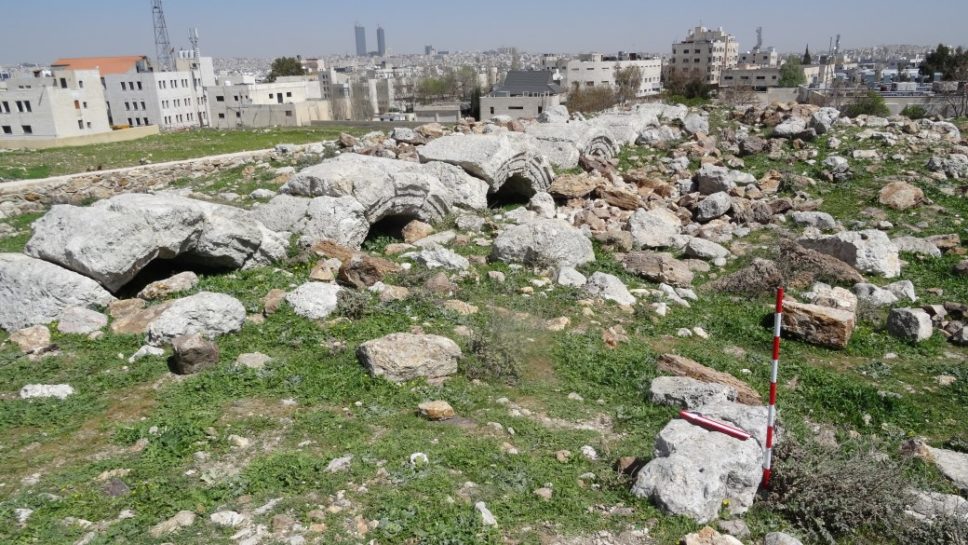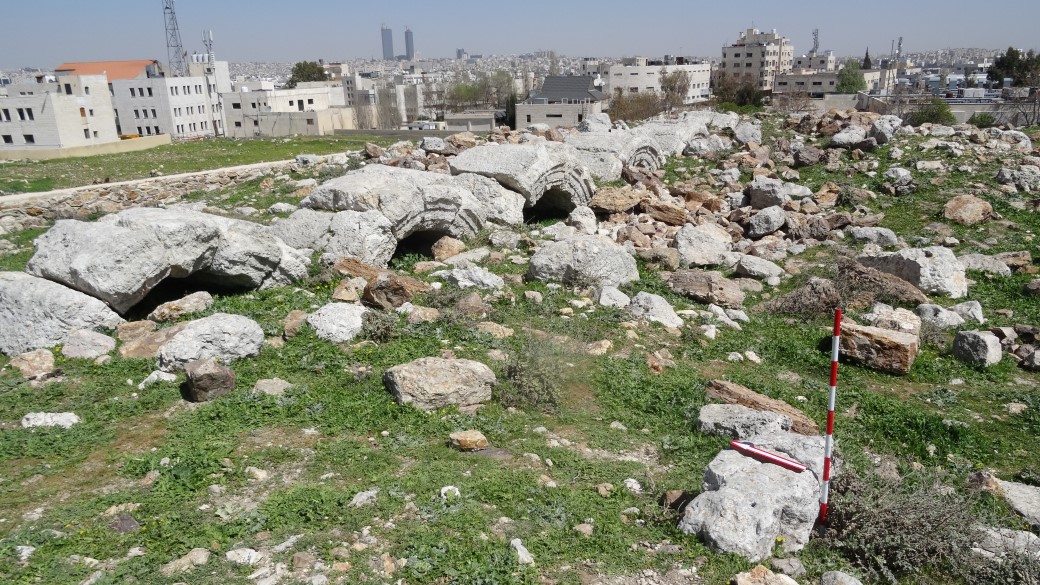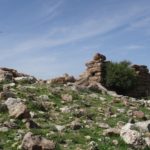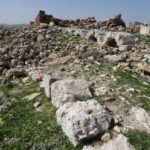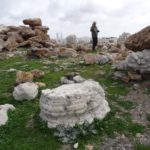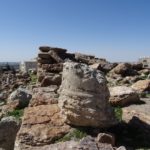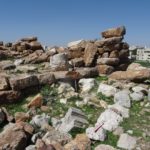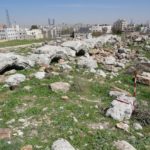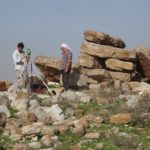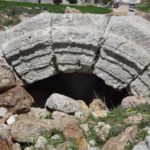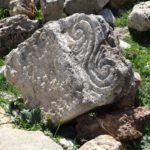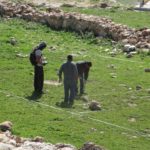Khirbat es-Sar
Khirbet es-Sar
Khirbet Sarah
Khirbet Sara
Khirbat Sara
-
Project name:
Non-invasive research at Khirbat es-Sar
-
Type of site:
Settlement, sanctuary, defensive site(?)
Location:
Jordan
Western suburb of modern Amman
Ancient Ammonitis (southern Gilead)Dating:
From the Iron Age (8th–7th century BC) to the 14th–15th century AD
History of research:
Dates of PCMA mission’s work:
2018–
Type of research:
Non-invasive research and survey
Directors:
Jolanta Młynarczyk
Mariusz Burdajewicz
Co-operating institutions:
– Polish Centre of Mediterranean Archaeology, University of Warsaw
– Institute of Archaeology, University of Warsaw
– Department of Antiquities of Jordan
Description of the site and research:
Khirbat es-Sar, the ancient name of which remains unknown, lies in the western suburb of modern Amman. Due to its location on the edge of a plateau (972 m a.s.l.) commanding a broad view to the south and west, it must have been an important strategic and trading point on the road linking the Jordan Valley with Rabbat Ammon-Philadelphia-Amman. Travelers from the second half of the 19th century and the first half of the 20th century mentioned or shortly described the site, but no field excavations were conducted there. It was included in the JADIS database (no. 2215017) and the new information system MEGA-Jordan (nos 3007 and 11304: two elements of the same site).
Many architectural relics have been preserved in Khirbat es-Sar, among them a magnificent architectural complex standing on the highest point of the terrain. It includes a square building, probably erected in the Iron Age, and a large arcaded courtyard added in the Roman period (2nd–3rd century AD), as evidenced by the characteristic material and building technique as well as the style of architectural decoration.
The PCMA mission conducted the first comprehensive reconnaissance in Khirbat es-Sar in March 2018. It included mapping all architectural relics visible on the surface and carrying out geophysical research using the electric resistivity method. As a result, the first complete map of the site was created. It substantially amended the only known plan of the temple complex, published in 1909 by H.C. Butler. It turned out that in front of the square cella of the temple (about 20 by 20 m) was a vestibule located on a lower level, which in turn was preceded by an even lower-lying square courtyard (31 by 31 m) with stairs leading to the vestibule. The courtyard had two side aisles, separated from the central part by two rows of arcades (seven in each row). The whole complex was aligned east-west with the entrance from the east.
During the field season, the team made a drawing and photographic documentation of the architectural elements, which were found mostly in the temple complex. Moreover, based on the collected surface finds, mainly pottery, it was possible to determine that Khirbat es-Sar functioned from the Late Iron Age to the late medieval period.
From the historical point of view, Khirbat es-Sar remains a mystery. It could be hypothetically linked with one of the enigmatic places mentioned in written sources, such as Jazer, Birta Ammanitis, or Beth-Fogor, but only further excavation work in the temple complex can provide an archaeological basis for its identification.
Information in the media:
sierpień 2018 Warszawscy archeolodzy badają starożytną osadę w Jordanii
Młynarczyk, J., Burdajewicz, M. with Appendix by Ryndziewicz, R. (2018). Archaeological survey at the site of Khirbat el-Sar/Sara) Jordan, with Appendix: Preliminary results of the geophysical survey at Khirbat al-Sar/Sara, Jordan. Polish Archaeology in the Mediterranean, 27/1 341–378.
Select site bibliography:
Villeneuve, F. (2020). Khirbet Sara (Jordan), 1983. In K. Jakubiak, A. Łajtar (eds), Ex Oriente Lux. Studies in Honour of Jolanta Młynarczyk, 309–322
Ji, Ch. (1997). Archaeology in Jordan. American Journal of Archaeology, 101:3, 499.
Glueck, N. (1939). Explorations in Eastern Palestine III. The Annual of the American Schools of Oriental Research, 18/19, 153–156.
Butler, H.C. (1914). Syria. Publications of the Princeton University Archaeological Expedition to Syria in 1904–5 and 1909, II A (p. 33). Leiden.
Conder, C.R. (1889). Survey of Eastern Palestine: memoirs of the topography, orography, hydrography, archaeology, etc. l. The ‘Adwân country (p. 153). London.
Merrill, S. (1881). East of the Jordan (p. 405). New York.
Gallery:
-
1. North-eastern corner of the temple’s cella, the so-called Ammonite tower from the Iron Age(?) / Północno-wschodni narożnik celli świątyni, tzw. “wieży ammonickiej” z okresu żelaza(?) (fot. J. Młynarczyk).
-
2. Remains of the temple complex, view from the south-east / Widok na pozostałości kompleksu świątynnego od południowego wschodu (fot. J. Młynarczyk).
-
3. Interior of the temple’s cella, view to the north / Wnętrze celli świątyni, widok na północ (fot. J. Młynarczyk).
-
4. Column fragment in the entrance to the cella, view to the south / Fragment kolumny w wejściu do celli, widok na południe (fot. J. Młynarczyk).
-
5. Vestibule of the temple, view from the south-east / Widok na westybul świątyni od południowego wschodu (fot. J. Młynarczyk).
-
6. Arcaded courtyard in front of the temple, view from the south-west / Widok na arkadowy dziedziniec przed świątynią, od południowego zachodu (fot. J. Młynarczyk).
-
7. Taking measurements in the temple / Prowadzenie pomiarów na terenie świątyni (fot. J. Młynarczyk).
-
8. Face of one of the arches in the southern row of arcades in the courtyard / Czoło jednego z łuków w południowym rzędzie arkad na dziedzińcu (fot. J. Młynarczyk).
-
9. Decorated cantilever, presumably part of the portal of the temple complex / Dekorowany wspornik, prawdopodobnie część portalu zespołu świątynnego (fot. J. Młynarczyk).
-
10. Detecting the remains of walls using the electric resistivity method / Detekcja pozostałości murów metodą elektrooporową (fot. J. Młynarczyk).

